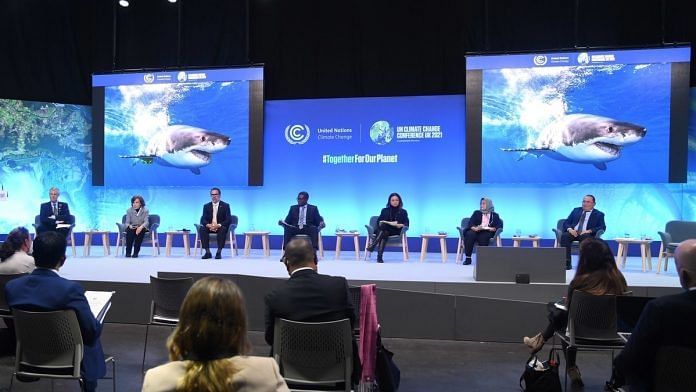New Delhi: Countries need to do twice as much as their targets for 2030 announced at the COP26 summit to keep global temperature rise below 1.5 degrees Celsius, a new report by independent research body Climate Action Tracker (CAT) has said.
Nations have assembled in Glasgow for the COP26 to figure out how to implement the Paris Agreement, adopted in 2015, and keep temperatures “well below 2 degrees, and preferably at 1.5 degrees” above pre-industrial levels.
Titled Glasgow’s 2030 credibility gap, the CAT report released Tuesday said current 2030 targets pledged at the COP26 will result in a 2.4°C rise in temperatures by the end of the century. If things continue with no change, the world is headed for a 2.7°C rise in temperatures.
Net-zero emissions pledges by 140 countries — including India — could bring temperatures down further if implemented sincerely.
“If all the announced net zero commitments or targets under discussion are implemented, this would bring our temperature estimate for this ‘optimistic scenario’ down to 1.8°C by 2100, with peak warming of 1.9°C. But this is only if these targets are fully implemented,” the report said, adding that most net-zero targets don’t have clear roadmaps.
The difference between countries’ 2030 actions and targets is 0.9°C, which the CAT report calls the “credibility” difference. “2030 actions and targets are more often than not inconsistent with net zero goals, so that the gap between current policies and net zero goals is now 0.9°C. This, we consider, is the credibility gap that Glasgow needs to address,” the report said.
Also read: There’s an $80 billion hole in India’s net zero pledge at COP26
Methane, deforestation pledges unlikely to work
During the talks at COP26, over 100 countries signed the Global Methane Pledge to bring down methane emissions by 30 per cent by 2030, and 12 pledged to end deforestation by 2030.
The methane pledge, which was initiated by the US, is said to help decrease temperatures by 0.2°C by 2050. The CAT report said this may not be the case.
“The pledge can only have a larger contribution to climate change mitigation if it is additional to the actions already committed by governments to meet NDCs (nationally determined contributions) and long-term strategies… A prominent example is the US, which has already partially included the 30 per cent methane reduction pledge by 2030 in its recently-submitted long-term strategy,” the report said.
The CAT report also said that countries must phase out coal by 2040 and reduce use of natural gas, “to keep the Paris temperature limit within reach”.
“To accelerate implementation globally, and ensure that all countries benefit from the transition to 1.5°C, developed countries need to massively increase international climate finance. Sufficient climate finance is critical to ensure that developing countries are able to meet their targets. None of the developed countries the CAT tracks have put forward sufficient climate finance,” it added.
India needs a clear roadmap to net-zero
According to the CAT analysis, only Chile, Costa Rica, the United Kingdom and the European Union have “acceptable” and comprehensive net-zero targets.
Canada, Germany, South Korea, and the US are “average” on the comprehensiveness of their targets, while China, Japan and New Zealand score poorly.
India hasn’t submitted enough information. “As with other recent net zero announcements, critical details on scope, target architecture, and transparency are lacking,” the report said.
“This target is incompatible with India’s huge coal pipeline and this issue needs to be addressed. Its first Covid-19 recovery package prioritised fossil fuels, but the second has some stimulus aimed at a green recovery,” it said.
On India’s updated climate targets at the COP26, the report said “at most, (it might) mildly improve emission reductions beyond current policies”.
(Edited by Amit Upadhyaya)
Also read: This is how a new era of global law will help us fulfil our goals of sustainability



